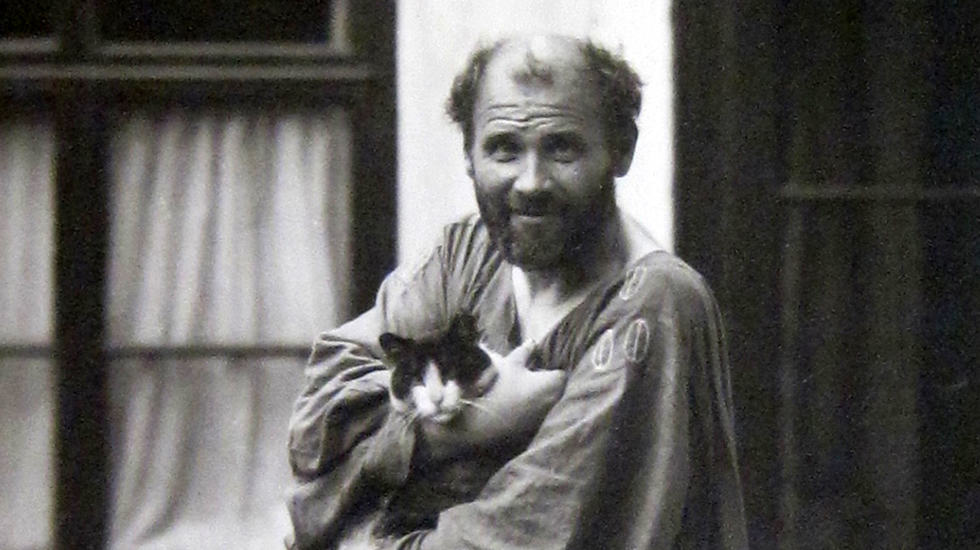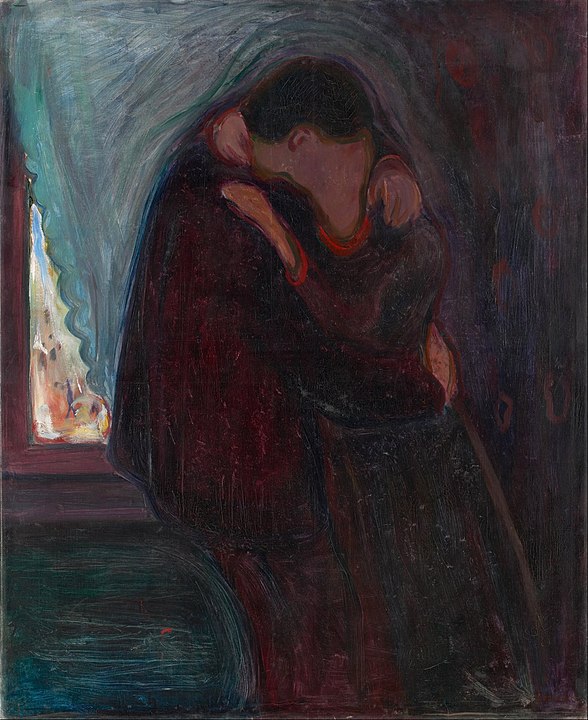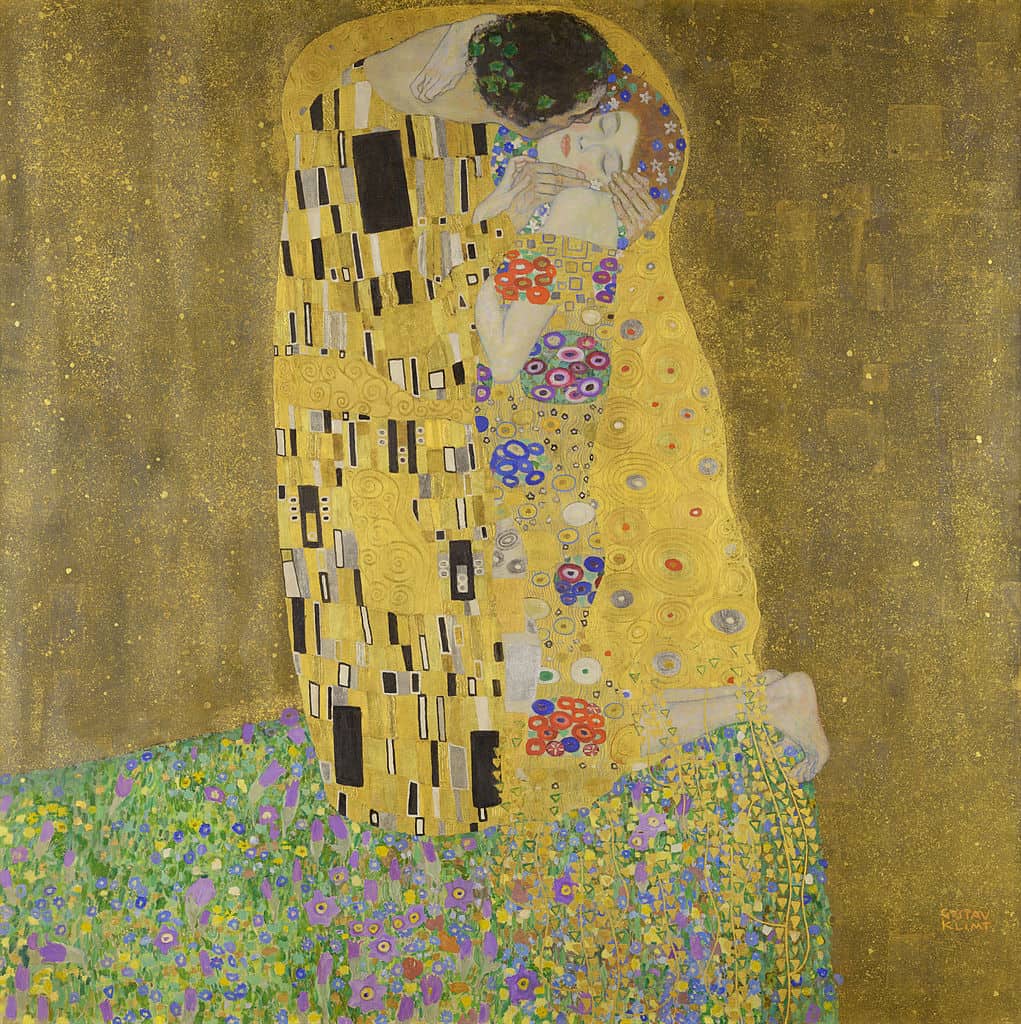Historical context
The kiss was created by Gustav Klimt in the end of the 1800s, in Vienna, while a group of artists, tried out new ideas that could change their fields. Vienna was the traditional city of academic art, Johann Strauss, and the Habsburg empire. On the other hand, it was home to radical artists like Gustav Klimt and Egon Schiele, whose explorations of sexual themes shocked audiences. Otto Wagner and Adolf Loos were challenging the style of the empire, and Gustav Mahler was changing the city’s music scene. And Sigmund Freud was about to change forever how we think about the mind.
There was a new “golden age” in Vienna. It was a city on the cutting edge of modernity, and it would have a big impact on the 20th century.
The Ringstrasse was built by order of Emperor Franz Josef in 1857. It’s a group of tree-lined boulevards that go all the way around the city. Along with new public buildings, the wealthy people of Vienna rushed to build huge mansions on the Ringstrasse. The grand palaces needed to be decorated, and Gustav Klimt and his brother were both excellent at painting murals. Gustav Klimt became one of the most well-known artists in the world without the usual cult of personality.
About Gustav Klimt himself
We don’t know much about him except that he never got married, had 14 kids with 14 different women, and died young. He had always lived with his mother and was afraid of getting crazy. Sigmund Freud almost had a classic case study on his hands. He put sexuality at the center of his work, just like Freud did.

Gustav Klimt
Klimt didn’t go to a school for fine arts. Instead, he went to a school for arts and crafts. A more practical education where he learned skills and methods. His goal in life was to get rid of the pretentious line between fine art and craft.
At age 20, Klimt and his younger brother were making allegorical murals for the new public buildings in Vienna. Their friezes showed traditional mythological scenes, like academic painting from the 19th century. But Klimt’s later, more radical work, can be traced back to his earlier work as a decorative artist.
Klimt’s art became more dramatic and darker after the sudden deaths of his brother and father. He would still use allegory and symbols, but in a new way that was more sexually explicit and, for some, more disturbing.
He was asked to make the university of Vienna look nicer. The paintings’ sexually provocative themes caused a huge public uproar, and Klimt was accused of making pornographic art. Women were told not to look at his work, and the university didn’t want to show them.
Klimt and a group of other young artists started the Vienna Secession, which was a very different kind of group. Their goal was to bring together art, craft, architecture, and design into one big movement. The secession broke away from the pompous historical painting that was popular at the end of the 19th century and gave modern art its first space of its own.
Austria is still a very traditional country, so this can be seen as the start of modern art there. Ironically, a painting that men think of as a romantic ideal was made by a man who had never been in a relationship and was afraid of getting close to people. A man who was obsessed with sex slept with most of his models and subjects, but he went home every night to his mother, whom he loved, and two sisters who were not married.
The Kiss by Gustav Klimt is square, and at six feet by six feet, it is almost as big as a person, which helps us relate to it on a human level. It is self-contained and looks easy, but it isn’t. It shows Klimt as a master draftsman who drew every day from real people.
The painting, The kiss by Gustav Klimt
There are a few things that make the kiss stand out.
For example, the contrast between the realistically drawn flesh and the abstract two-dimensional decorations creates an effect that is almost like a photo montage.
The paint on the bodies gives them a cool, modern sensuality. They are wrapped in gold and patterns that look like ancient Egyptian mummies. Everything looks like it is floating in a golden cosmos that is outside of time and space.
The background is a new piece of technology that Klimt made. He used sheets of gold leaf to cover the whole canvas. He then painted over the gold with a dark wash and flicked flakes of gold on top. If we look at where the background meets the meadow, which is painted in the usual way, we can see how the artist was playing with different textures.
In The Kiss, he used eight different kinds of gold. He also adds texture under the gold leaf to make it look three-dimensional and catch the light, just like Byzantine mosaics do. Gold is what comes to mind when we think of Klimt. His father was a goldsmith, and Klimt has been interested in gold all his life.
He went to Ravenna to see the Byzantine mosaics, which had a big impact on what he called his “Golden period.” The Kiss, which shines like an altarpiece, has become a symbol of the post-religious age. The gold around them almost looks like a halo. Gold leaf is fragile and comes in sheets that are as thin as tissue paper.
Klimt would use gesso, which is made of animal glue and chalk dust, for the parts of the painting that are raised. He would paint the thick mixture on in the pattern that was needed, and then he would put the gold leaf on top. The extra was then thrown away.
The other precious metal we see here is Platinum, which looks like silver but is actually more expensive than gold and doesn’t rust like silver does. There is more pure Gold in The Kiss than you might think. If we take a look at this UV scan. All the dark parts, including the background, are covered with a layer of pure gold leaf. Only the white spots show where there is no gold leaf. Even after putting gold leaf on the surface, we can see that Klimt is happy to paint over the gold and mix both materials and textures.
He doesn’t use Gold because it looks real. It’s too shiny and makes too much light, which makes it more of a thing to want. Gold is a sign of wealth, and because it doesn’t tarnish, it has been used for hundreds of years to decorate the tombs of Gods and in religious paintings.
Klimt uses gold to make the women of Vienna’s Nouveau Riche style look important, rich, and beautiful. The main idea wasn’t new, but the blatant sexuality was.
Klimt knew about Edvard Munch’s painting from more than 10 years ago, and both of them knew about Rodin’s sculpture from even earlier.

Edvard Munch, The kiss
When Klimt painted an embrace for the first time, he showed a couple about to kiss. The artist, who never had a romantic relationship, put the heads of old age, disease, and death above the young couple. He tells us that passion is full of doubts.
The Beethoven frieze was part of a successful Secessionist group show that was based on Beethoven’s 9th symphony. A turning point in the art of both Vienna and Klimt.
The composition and style of Klimt’s “Freieze” are similar to “The Kiss,” which is a painting of a couple kissing. Here, the word “love” is surrounded by demons.
The Stoclet frieze is a privately commissioned mosaic that shows a sexually suggestive embrace, which is the same theme as The Kiss. As in the Stoclet frieze, Klimt gives the impression that the couple kissing is naked underneath their clothes.
.jpeg)
Remembering what the average Viennese couple wore at the time can help us understand why it was seen as so provocative.
Klimt liked Aubrey Beardsley, and his clothes were influenced by his Art Nouveau style and “The Arts and Crafts Movement” organic shapes. The clothes are a visual representation of how erotic love makes people feel and act. His robe has black rectangles standing up straight, which is a sign of strength.
People say that the spirals and whirls on her robe represent the Ova. I don’t think it’s a coincidence that the shape of the two people who are holding hands is a Golden Phallic symbol.
Klimt’s figures often look stiff and statue-like. He was said to have been influenced by the Belgian sculptor George Minne, who used what was called the perfect “Gothic” body: a thin, expressive, and young-looking body. Minne also had an effect on younger Austrian artists like Klimt followers Egon Schiele and Oscar Kokoshka. Like Monet and van Gogh, Klimt collected Japanese prints, which had a huge effect on him.
The composition is very simple, and the man’s head is painted very close to the top of the canvas, which is another sign of “Japonisme.” A change from the usual way Western art is made.
Whoever wants to know something about me as an artist which alone is significant they should look attentively at my pictures and there seek to recognize what I am and what I want.— Gustav Klimt

Gustav Klimt, The kiss
Klimt’s complicated feelings about “love” are shown in The Kiss. The figures are standing in a flowery meadow, but they are on the edge of a cliff.
Even though the lovers are compared to religious icons, they have a very “pagan” look with the garlands in their hair. The fact that the man is wearing a crown of vines and the woman is wearing a crown of flowers suggests that this is the end of a ritual.
One idea is that Klimt is showing the story of Apollo and Daphne from Ovid’s metamorphosis in this painting. Most artists who show the story show Daphne running away from Apollo as she begs the gods to turn her into a laurel tree so she can be safe from Apollo’s advances. But the last sentence of Metamorphosis talks about “a kiss” that happens AFTER she has turned into a tree, which is rarely shown. In The Kiss, the woman’s legs seem to be sinking into the ground as Golden Laurel leaf tendrils grow out of her body and grow roots in the meadow. This shows that Daphne has changed into a Laurel tree.
The viewer doesn’t see the man’s face. Klimt almost always painted women, and when he did paint men, they were just a small part of the picture. He is bending down to kiss the woman on the cheek, and his hands are on the woman’s face, which is facing the viewer. Her eyes are shut, as if she were in a trance or ecstasy. She has one arm around the man’s neck and the other resting softly on his hand. Her face is turned up to get a kiss from the man… or is it?
Who are the models is one of The Kiss’s biggest mysteries. People think this is a picture of Klimt and Emilie Floge. She ran a business and made fashions that were new and different. A woman who lived 27 years with Klimt and was way ahead of her time. It looks like the relationship may have started with him being in love with her. But over time, it grew into a very close friendship that was more intellectual and emotional than physical.
She looks a lot like a woman named “Red Hilda,” who is more likely to have been the real-life model. She was one of Klimt’s many lovers and the subject of many of his paintings. People have talked for a long time about what the relationship between the two is. Is it lovey-dovey? Is she bending down to kiss him or turning her back on him?
If we do think of it as an allegorical portrait of Klimt and Floge, then the ambiguity of the relationship in the painting is a perfect reflection of their own ambiguous relationship. The man tries to kiss her, but she turns her head away. There is tenderness and an acceptance of affection, but she does not give in. Her eyes and mouth are tightly shut, which is unusual for Klimt’s paintings, where women often have their mouths open in a sexual way.
Long thought to be the most romantic painting ever made, The Kiss might actually be a picture of a friendship. When it was shown in Vienna, the Austrian government bought it right away. Klimt’s work, which was once seen as sexual and weird, was shown in one of the Imperial palaces.
Gustav Klimt would be part of the last cultural explosion before the fall of the Austro-Hungarian empire, a political entity that was ridiculously out of date at the time and would die in the same year as Klimt, 1918.
A few months after that, Egon Schiele would die. And just like that, a time of great creativity and energy came to a close. Critics today often say that Klimt was just an artist who made “decorative artifice.” But his work was an important link between academic realism and the world of abstraction that was about to come. Freud said that he pushed the limits of “the misunderstood and much criticized erotic.” And showed people in ways that had never been done before.
Then he gave us “The Kiss,” which is one of the most powerful and honest pictures of the 20th century. We don’t know what Klimt really thought about “The Kiss,” but maybe we don’t need to. “If you want to know about me, look at my paintings,” he once said.
You can buy an oil painting replica of Klimt’s The kiss by following this link.
.jpg)
